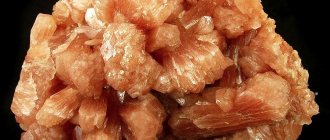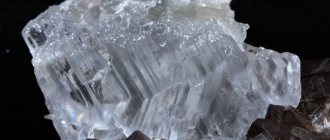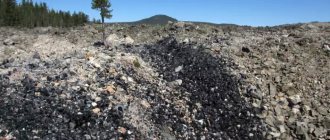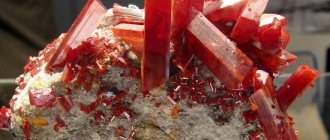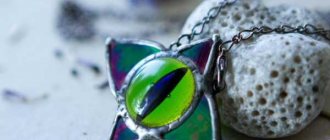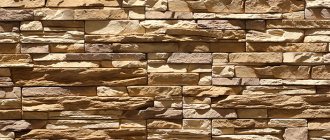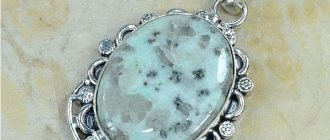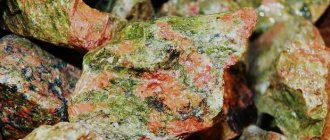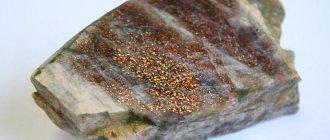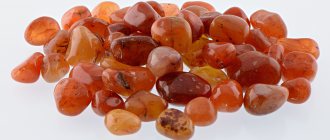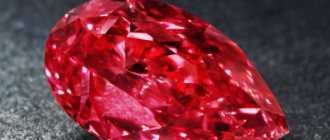Jasper is one of the most common minerals on Earth. The rich palette of shades, exquisite patterns, physical properties of this stone, and unusual texture attract jewelers and stone carvers. We will tell you what jasper is in this material. You will learn what this mineral looks like, how it is formed, when it began to be mined and where it is used.
Description of Jasper
The concept “jasper” combines a large class of siliceous rocks. Amazing patterns on the surface of the mineral and a variety of colors are formed due to various impurities, which affect the appearance of this semi-precious stone. The color palette of jasper is wide - from white to red and blue shades. There are purple, green and even black minerals. Stones of pure color are practically never found in nature. Much more often, the structure of jasper contains various inclusions. They create stripes, light or dark spots, and patterns that resemble fantastic landscapes.
In ancient times in Rus', jasper was called jasper. This name comes from the Greek iaspis, which translates to “variegated.” In European countries, the mineral had several names: German lapis, tiger stone, meat agate. The current name of the mineral became popular in the 50s of the 19th century.
Cost of products
Let us note only the cost of jewelry. The price depends on the frame and type of jasper. So, earrings will cost from 7 to 20 dollars per pair.
The cost of rings depends on the processing and type of mineral. Some species reach the price of precious gems. But still, rings are available to the average citizen.
The same can be said about bracelets. They are often made in sets and include other minerals that match in color or compatibility. Depending on the set, the price may increase due to “neighbors”.
When did the mineral begin to be mined and used?
People have known about what jasper is since Neolithic times. In those distant times, people valued this stone for its high hardness. Tools, spearheads and arrowheads were made from it. This fact is confirmed by numerous finds of archaeologists discovered during excavations in the areas where Neanderthal sites were located.
Like most semi-precious stones, jasper began to be used in jewelry when the art of processing this mineral reached a fairly high level. The stone was considered magical and sacred. For this reason, amulets, talismans, and symbols of religion were made from it. Jasper decorations began to appear on the clothes of rulers and priests.
In the Middle Ages, jasper was used to decorate temples and churches. In Europe, the mineral was considered a symbol of modesty, fortitude, and courage. That is why jasper was worn by monks and priests. The active use of this semi-precious stone in Russia began only in the 18th century, when the gem became especially popular as a durable and beautiful facing material.
It was used to decorate palace halls and rooms; magnificent furniture was inlaid with jasper. The paintings made from the thinnest jasper plates were real masterpieces. In all centuries, Ural jasper has been recognized as the highest quality. In the 19th century, it was considered the unsurpassed leader among all minerals mined in the world.
From the history
This is a crystal with a dense structure of the silicon variety, which acquires a glossy shiny hue during processing. Experts call jasper those rocks of minerals that consist of quartz grains connected by cement clay. The composition of cement clay, among other things, includes flint and chalcedony, which provides the stone with its special strength.
There are a great many varieties of jasper, and scientists still do not understand how this stone can have such a huge number of species.
If we are talking about high quality jasper, its origin should be sought in volcanic mineral rocks, which have come a long way, starting from greenish structures in the form of schists. Jasper, used for ornamental purposes, arises by silicification of primary mineral compounds when they combine with magma of volcanic origin. Scientists of various times and eras have always tried to tell the history of the origin of jasper in a way that would be interesting and educational. Academician A.E. Fersman created a wonderful literary work about this stone, which can be called truly enchanting.
Once upon a time, many millions of years ago, in a place called today the Ural ridge, the real kingdom of Nature was located. The rich landscape was replete with shallow rivers, islands and endless expanses of sea. Of course, in those distant times there was no trace of mountain-forming rocks. But, since we are talking about the Devonian period of the planet’s development, volcanic eruptions already took place then. And the tectonic movement of plates under the waters greatly changed the structure of the earth's crust.
The seabed was teeming with underwater fauna. Numerous animals, to which modern science cannot give either a name or an external description, developed in a little-known and mysterious way, lived and died from volcanic eruptions, underwater disasters and lava settling on the ocean floor. The skeletons of once living creatures, plunging deep into the muddy bottom, petrified, acquiring the structure of silicon rocks. And the most complex chemical transformations of the earth’s crust brought about irrevocable changes to the structure and structure of the soil.
Stone formation
To understand what jasper is, you need to know how the mineral is formed in nature. The basis of the semi-precious stone, which belongs to quartz crystals, is silicon. Any mineral rock that contains quartz grains held together by a flint-chalcedony cement composition can be called jasper.
For a long time, geologists were interested in the origin of jasper, but the peak of study of this amazing mineral occurred in the 18th-19th centuries. There are a huge number of varieties of jasper, and the origin of some of them remains a mystery today.
Scientists have come to the conclusion that high-quality jasper is primarily a volcanic rock. In addition, there are varieties that were formed during the fossilization of ancient marine animals and plants.
Chemical characteristics of the mineral
Chalcedony and quartz make up from 60% to 95% of the total mass of the stone. The remainder is manganese and iron oxides. These metals in various proportions color jasper green, brown, black and blue. The chemical formula of this mineral is characteristic of quartz - SiO2. Its composition may contain a fairly high level of impurities (up to 20%). Jasper may contain the following elements:
- Hematite. Thanks to it, the mineral turns pale pink or deep red.
- Iron. Gives the mineral shades of yellow and brown.
- Magnetite. The stone is painted in quite rare colors - black and purple.
- Chlorite. With a high content of this substance, jasper acquires the whole range of green shades.
Jasper is often found in nature with an admixture of garnet. It depends on its shade whether the resulting jasper will be red or green. More rare and valuable specimens are stones containing fossils of ancient algae.
Physical and chemical properties
Jasper is a rock. It is of sedimentary origin, but sometimes samples of volcanic origin are found.
Basic properties:
- Almost any color, texture varies;
- Chemical formula - SiO2 80-95%; Al2O3 and Fe2O3 up to 15%; CaO3 - 6%;
- Density - 2.6 g/cmᶾ;
- The fracture is smooth (becomes conchoidal);
- Mohs hardness - 6.5-7;
- Gloss - glossy, glassy or waxy;
- Cleavage - absent;
- The composition is very diverse (the amount of impurities can reach up to 20% of the total volume).
Geologists classify jasper as silicates that are excessively contaminated with foreign impurities. The mineral can be polished and has many patterns, which is beneficial to those who want to fake it.
Main deposits
Jasper deposits are found throughout the world. The largest and most famous of them are located in Russia, India, the USA, Egypt, and in some European countries - Germany, France, and the Czech Republic. The most ancient mining sites are concentrated in Egypt and India.
The most famous jasper deposits in our country are located in Altai and the Southern Urals. In the Urals, deposits stretch from north to south. Eight unique types of jasper are mined here:
- Landscape (variegated, Orsky). Black and brown dendrites of iron oxides resemble shrubs and trees. The gray background of the minerals resembles a foggy, hazy morning sky.
- Kalininskaya monochromatic, gray-greenish jasper.
- Koshkuldinskaya ribbon, which has no analogues in the world, with beautiful combinations of thin dark or bright red and crimson, green stripes.
- Yamskaya streamy dark cherry or fawn color.
- Malomuinakovskaya ribbon, which has a unique flowing pattern of wide dark green and fawn ribbons.
- Aumkul landscape jasper of a delicate fawn tone with brownish or black tree-like images.
- Variegated Urazov jasper.
- Purple berkutina.
The most unusual variegated varieties are found on Mount Colonel in Orsk.
Deposits in the CIS
As mentioned earlier, jasper has deposits all over the globe, with the most popular stones found on the territory of the Russian Federation. In Russia there is a famous deposit of unusual jaspers, on which you can see incredible landscape patterns. Such beautiful minerals can be found in the mountains near the city of Orsk, light pink gems are mined in the Aushkulskoye deposit, jasper with striped veins of scarlet and malachite shades is mined in Nauruzovskoye, and gray-blue and reddish jasper is found in Muldakaevskoye. Impressive deposits of gem deposits are located in the Zmeinogorsk region in Altai. But the deposits of the Southern Urals stretch over more than 500 km in the east of the Ural ridge. The belt of jasper deposits is not a continuous line, it is more like a necklace, because they are found in small areas. Today, geologists have identified more than 200 deposits in 12 regions of the country.
Jasper is also mined on the territory of Uzbekistan in the Kumsareksaik deposits. In Kazakhstan, minerals are mined in Karatassky, and in Georgia in Kutaysky. Tanjikistan is famous for the Kalaikhumb deposit. Jasper can also be found on the Crimean Peninsula.
Application of jasper
Jasper is a mineral valued by specialists and gem connoisseurs for its decorative properties. The variety of colors and patterns allows the mineral to be used in jewelry and stone cutting. Jasper jewelry (you can see photos of some samples below) is quite interesting and exquisite. And this despite the fact that, as a rule, silver and brass are used as the basis, and much less often gold. Paintings and decorative items made from this mineral are highly valued. Tourists from abroad are happy to purchase souvenirs made from this mineral.
Due to the high strength of stone, it is used as a technical raw material. Prisms, rollers, stone mortars, etc. are made from it. Jasper is also used in interiors as an elite and expensive finishing material, which is used to decorate walls and floors, fireplaces and columns. Jasper crumbs can be used to decorate the site and garden.
A little about the composition and drawings
The place where jasper is mined determines the main characteristics and properties of the stone. Uniformly colored minerals are composed of sedimentary rocks formed through metamorphism. During the formation process, jasper does not recrystallize, and its extraction occurs in the same way as any technical raw material.
The basis of the composition is chalcedony quartz, and if we translate the name of the stone from Greek, we get the word “variegated”, which perfectly reflects the essence. The wonderful diversity of jasper and the amazing patterns on it are nothing more than the result of the presence of a large number of mineral mixtures in it.
Medicinal properties
Since ancient times, people have known what jasper is. The healing properties of the mineral have been used since ancient times. In China, jasper was used to treat diseases of the liver, kidneys and stomach. The ancient Romans were sure that wearing this stone around the neck significantly speeds up recovery from many ailments. And the Greeks believed that the healing power of a stone depended on its color:
- White jasper helps with despondency and depression, alleviates neurotic disorders.
- Red jasper was used to stop bleeding. It is used to prevent many female ailments and normalize the menstrual cycle in case of blood pathologies.
- The brown mineral prolongs youth, is able to treat dermatitis and allergies, and mental disorders.
- Yellow jasper has a beneficial effect on the endocrine system, improves the absorption of vitamins C, B and A, and various microelements. It treats gallbladder pathologies and removes toxins from the body.
- The green mineral improves digestion and breathing, sense of smell and vision, and strengthens blood vessels.
Properties of the stone: who is jasper suitable for?
The elements of the mineral are Earth and Air, and its planets are Jupiter and Mercury.
Jasper relieves Virgos of the passion for teaching, makes their character more reasonable and easy. The mineral is also suitable for Capricorns (but only light shades). Under the influence of the gem, Taurus will forget about outbursts of anger, get rid of conservatism, and acquire flexible thinking. Who else is jasper stone suitable for? The properties of the mineral, according to astrologers, patronize creative people, so it is suitable for Aquarius and Gemini. A talisman with such a stone should be purchased by Libra: it will give them greater confidence in their abilities and relieve them of the doubts that haunt them. Jasper helps Sagittarius and Leo to find peace of mind. But the stone can harm Aries: representatives of this sign may lose self-confidence, and the mineral will bring them bad luck.
Jasper supports sensitive and vulnerable representatives of the sign of Pisces. She gives them creative ideas. The gem significantly softens the character of Scorpio and establishes his contact with people. The mineral can be useful for Cancers, but only in its light shades (white, blue, light green). Red stones will make Cancer experience failures more strongly and deprive them of mental strength.
Compatibility with zodiac signs
Natural minerals are often chosen as amulets. It is important to know who suits jasper according to their zodiac sign. In this regard, the question arises, who is jasper suitable for?
This is a suitable option for Virgos . Helps these representatives to be on the same wavelength with those around them, endows them with wisdom and prudence.
Pendant with the sign of Virgo
Suitable for Pisces . The stone gives these signs self-confidence. Helps to clearly see reality and recognize deception. Pisces always has their head in the clouds. This prevents them from realizing themselves. The gem will take control of the situation.
But Gemini and Aries should not choose jasper talismans. The amulet will not help them; it will exacerbate the most negative character traits. It will make you unbearable and put you at odds with your friends.
Other zodiac signs can choose a jasper amulet. The gem will not cause any harm. But it is worth knowing that there are stones that are more suitable for them. Experts advise wearing the stone for some time. If you feel dizzy or tired, it means it is not suitable. Representatives of the elements of Fire and Air should heed this recommendation.
Interesting facts about jasper
We told you about what jasper is. Several interesting facts about the mineral will complement the information received:
- This mineral is still considered one of the most powerful healing stones today.
- The unique Buddha statue, which is entirely carved from green jasper, weighs five tons. It is located in one of the temples in Thailand.
- A very hard mineral, which was a symbol of perseverance, was used in the manufacture of a mace for Bohdan Khmelnytsky himself.
- The Hermitage houses a huge collection of jasper products. A giant vase with a diameter of more than five meters, weighing 19 tons, is the largest exhibit in the museum. The vase is made of Revnev jasper, which is distinguished by its exquisite ribbon ornament and greenish tint.
- Jasper was also used to decorate the palaces of the Moscow Kremlin: fireplaces were lined with beautiful blue stone.
- Some gem nuggets were so valuable that they were equated with precious stones.
- Many prominent Russian artists and scientists valued jasper. Lomonosov and Pushkin especially loved this stone. The latter believed that jasper gives good luck in love.
How to distinguish a real stone from a fake?
Most often, natural stone is replaced with ordinary plastic. In order not to buy a fake instead of a genuine piece of jewelry, you need to pay attention to several aspects:
- Plastic, unlike hard and dense jasper, is a fragile material.
- Natural stone has a characteristic waxy sheen; it is not transparent and can be easily polished with suede.
- The stone remains cold in the hand longer, unlike plastic.
- Jasper is significantly heavier in weight than plastic of the same size.
To avoid buying a fake, never buy gems from street stalls. The risk of purchasing counterfeit jewelry in a jewelry store is significantly reduced. But you shouldn’t let your guard down there either.
